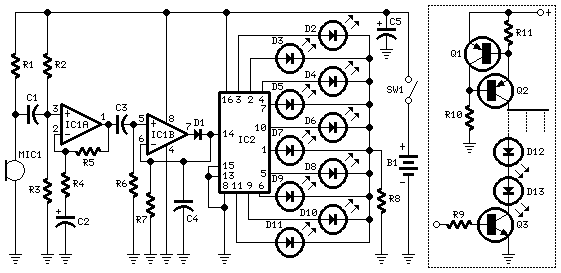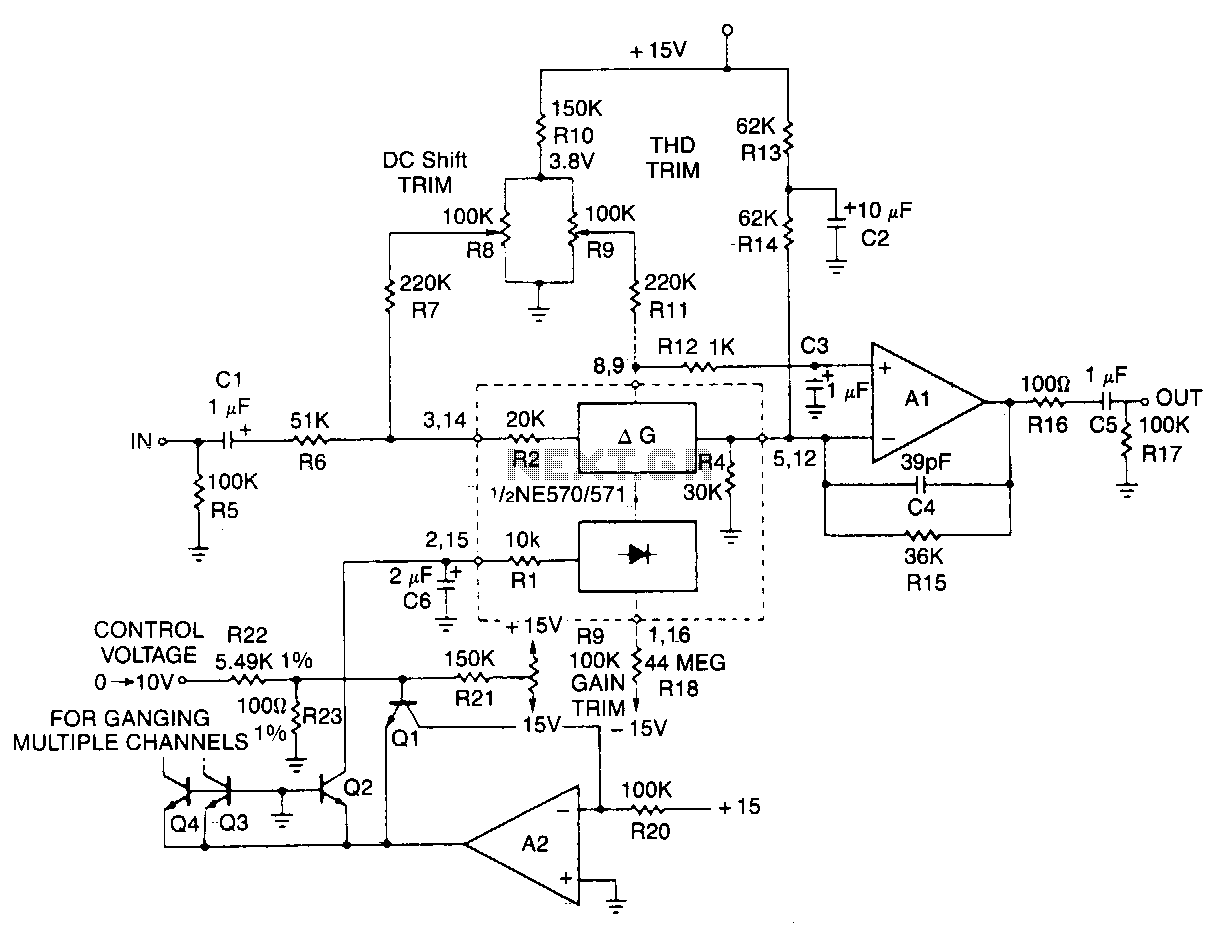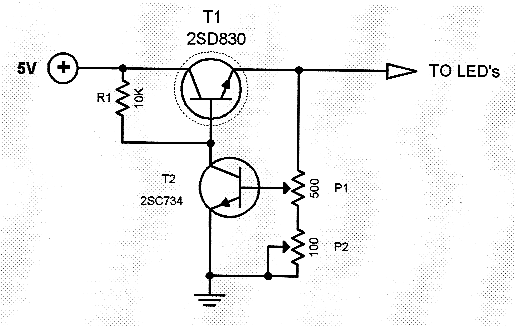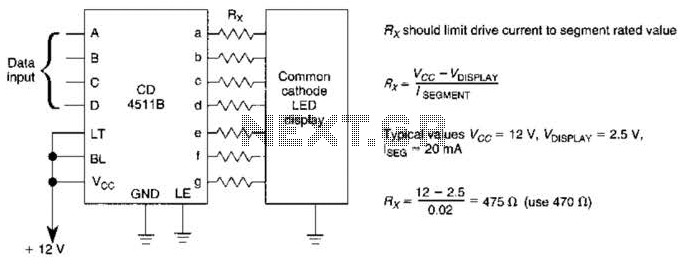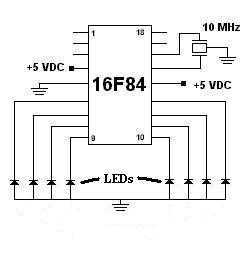
LED Lighting For Consumer Unit Cupboard
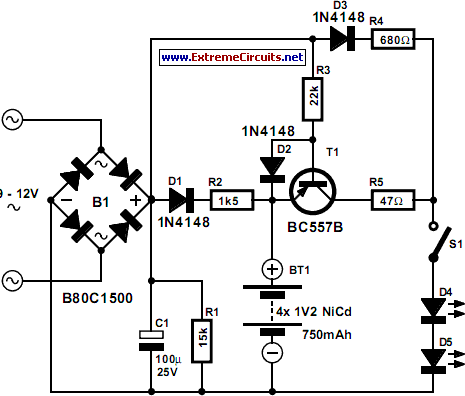
The consumer unit cupboard in some older houses is poorly illuminated. If a bell transformer is also situated in this cupboard, it can be utilized to provide emergency lighting using two high-current LEDs. These diodes are powered through a small circuit that switches to four NiCd batteries when the mains power fails. The output voltage of the bell transformer is rectified by bridge B1 and smoothed by capacitor C1. The batteries receive a continuous charge of approximately 7.5 mA via diode D1 and resistor R2. The base of transistor T1 is held high by resistor R3, keeping the transistor in the off state. During a mains voltage failure, capacitor C1 discharges through resistor R1; when the voltage drops to a specific threshold, the battery voltage activates T1 through resistors R3 and R1, provided switch S1 is closed. Once T1 is activated, a current of about 20 mA flows through diodes D4 and D5, providing enough illumination to identify a blown fuse or a tripped circuit breaker.
The circuit described serves a critical function in ensuring safety and convenience in older residential electrical systems. The consumer unit, often located in a dimly lit area, can pose challenges during power outages, particularly when identifying electrical issues such as blown fuses or tripped breakers.
The system begins with the bell transformer, which converts the mains voltage to a lower voltage suitable for charging the NiCd batteries and powering the LED lights. The bridge rectifier (B1) converts the alternating current (AC) output of the transformer into direct current (DC), which is then smoothed by capacitor C1 to provide a stable voltage for the LEDs and charging circuit.
Charging of the NiCd batteries occurs continuously under normal operating conditions, with diode D1 preventing reverse current flow when the mains power is available. The charging current of approximately 7.5 mA, limited by resistor R2, ensures that the batteries remain topped up without overcharging.
In the event of a mains failure, capacitor C1 discharges through resistor R1, which acts as a timing element. The voltage across C1 decreases until it reaches a level that allows the battery voltage to turn on transistor T1. This transition is facilitated by resistors R3 and R1, which form a voltage divider that controls the base current of T1. When T1 is activated, it allows current to flow through diodes D4 and D5, illuminating the LEDs. The combined output of these high-current LEDs is designed to provide sufficient light to navigate the consumer unit area, enabling users to locate and address electrical issues safely.
Overall, this emergency lighting circuit is a practical solution for enhancing visibility in critical areas during power outages, thereby improving safety in residential electrical installations.The consumer unit (or electricity meter`) cupboard in some older houses is a badly lit place. If the bell transformer is also located in this cupboard, it may be used to provide emergency lighting by two high-current LEDs. These diodes are powered via a small circuit that switches over to four NiCd batteries when the mains fails.
The output voltag e of the bell transformer is rectified by bridge B1 and buffered by capacitor C1. The batteries are charged continuously with a current of about 7. 5 mA via diode D1 and resistor R2. The base of transistor T1 is high via R3, so that the transistor is cut off. When the mains voltage fails, C1 is discharged via R1; when the potential across it has dropped to a given value, the battery voltage switches on T1 via R3 and R1, provided switch S1 is closed. When T1 is on, a current of some 20 mA flows through diodes D4 and D5. The light from these LEDs is sufficient to enable the defect fuse or the tripped circuit breaker to be located.
🔗 External reference
The circuit described serves a critical function in ensuring safety and convenience in older residential electrical systems. The consumer unit, often located in a dimly lit area, can pose challenges during power outages, particularly when identifying electrical issues such as blown fuses or tripped breakers.
The system begins with the bell transformer, which converts the mains voltage to a lower voltage suitable for charging the NiCd batteries and powering the LED lights. The bridge rectifier (B1) converts the alternating current (AC) output of the transformer into direct current (DC), which is then smoothed by capacitor C1 to provide a stable voltage for the LEDs and charging circuit.
Charging of the NiCd batteries occurs continuously under normal operating conditions, with diode D1 preventing reverse current flow when the mains power is available. The charging current of approximately 7.5 mA, limited by resistor R2, ensures that the batteries remain topped up without overcharging.
In the event of a mains failure, capacitor C1 discharges through resistor R1, which acts as a timing element. The voltage across C1 decreases until it reaches a level that allows the battery voltage to turn on transistor T1. This transition is facilitated by resistors R3 and R1, which form a voltage divider that controls the base current of T1. When T1 is activated, it allows current to flow through diodes D4 and D5, illuminating the LEDs. The combined output of these high-current LEDs is designed to provide sufficient light to navigate the consumer unit area, enabling users to locate and address electrical issues safely.
Overall, this emergency lighting circuit is a practical solution for enhancing visibility in critical areas during power outages, thereby improving safety in residential electrical installations.The consumer unit (or electricity meter`) cupboard in some older houses is a badly lit place. If the bell transformer is also located in this cupboard, it may be used to provide emergency lighting by two high-current LEDs. These diodes are powered via a small circuit that switches over to four NiCd batteries when the mains fails.
The output voltag e of the bell transformer is rectified by bridge B1 and buffered by capacitor C1. The batteries are charged continuously with a current of about 7. 5 mA via diode D1 and resistor R2. The base of transistor T1 is high via R3, so that the transistor is cut off. When the mains voltage fails, C1 is discharged via R1; when the potential across it has dropped to a given value, the battery voltage switches on T1 via R3 and R1, provided switch S1 is closed. When T1 is on, a current of some 20 mA flows through diodes D4 and D5. The light from these LEDs is sufficient to enable the defect fuse or the tripped circuit breaker to be located.
🔗 External reference

